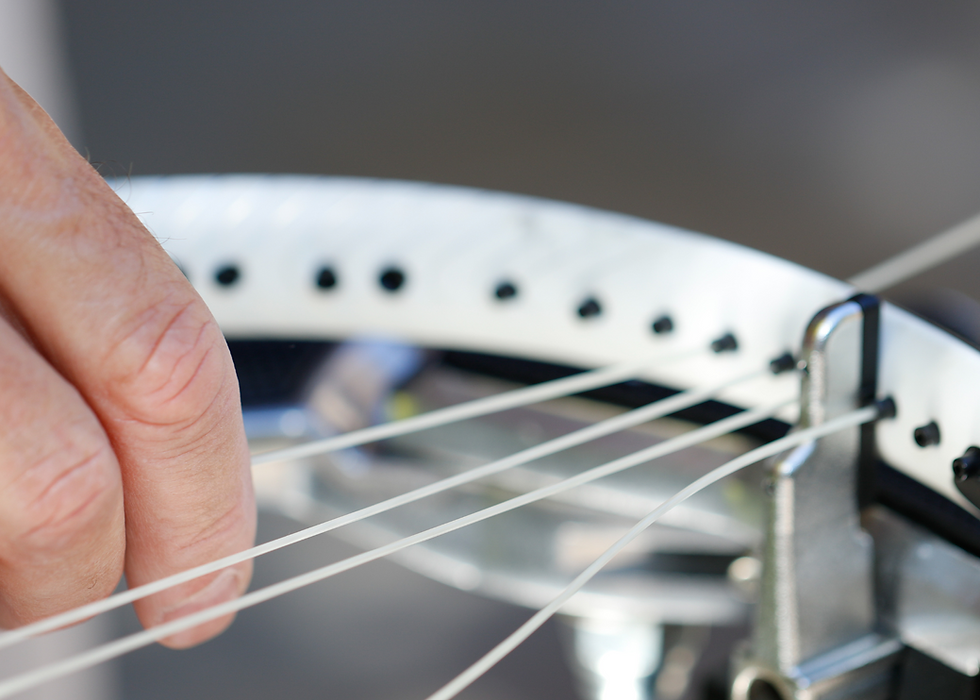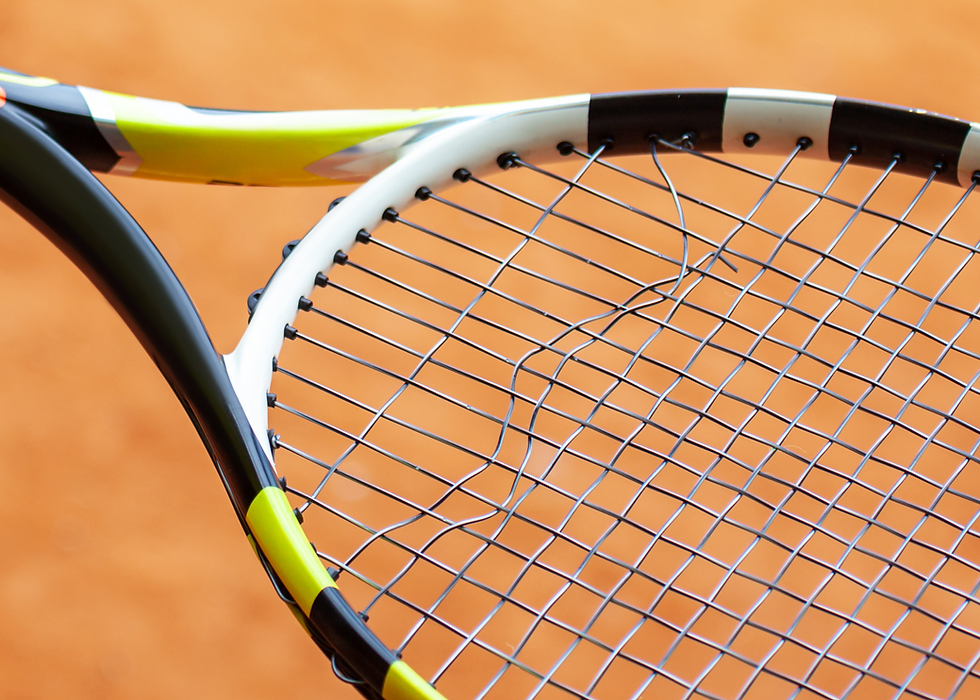Tennis Tip: String, Beautiful String!
- Team Game-Set-Match

- May 12, 2020
- 7 min read
Updated: May 29, 2024

Strings, Strings the magical foe, the more you play, the more you know, the more you know, the better they show, let’s learn about string and spend some dough! wink wink (You know the tune)
This month is warming up and it's time for a racket tune-up! Strings are highlighted this month because they are an important weapon in your game! Strings are like an oil change for your car - changing them regularly and choosing the right kind for your game makes a big difference in performance. There are many, many, many strings and brands to choose from, so this tip is going to review 7 types of strings, all in different brands after explaining the choices. I won’t string you along any further, let’s get educated! The different types of string are Synthetic which includes Poly Blends, Multifilament, Hybrids, Aramid, a high-fibrous string that can be made of Kevlar or Zyex, an almost metallic-like material, Shaped/Textured string, designed to create spin, in hexagonal, triangle, 6-sided cog shaped, 7-sided, 8-sided and more; and Natural Gut, the big poppa of all string. A breakdown to follow. Gauge Explained: String comes in different gauges, meaning diameter, ranging from 1.10-1.35mm or converted to gauge: 15 gauge to 19 gauge. Gauge enables you to move through different levels of elasticity and durability. When considering gauge, think of strings as a knife through butter-the more it can slice/cut(smaller diameter/gauge), the better the spin but the thinner the gauge, also the easier to break and wear down. On the other hand, the thicker the gauge (larger diameter), the more shock is absorbed (greater surface area) and the longer lasting. With strings, there seems to always be that face-off between durability and feel. This too drives manufacturers to find the best of both worlds in one string! String, Beautiful String Different materials and techniques are used in constructing string and make a huge difference in flexibility, stability, spin and feel. Read on to understand some of these differences and think about what you might want out of your new string! Synthetic Gut - is another name typically used for nylon strings in varying constructions and can be made of various raw material additions to this nylon base. ‘The words “poly” and “nylon” are the basic materials synthetic can consist of and creating more complex compounds make what are called filaments. ‘Filament’ is a common term meaning how the string was created. Synthetic includes basically any string that is not natural gut. Synthetic includes poly and multifilament and is used as an umbrella term for so many types of string. Poly Blend - Polyester strings have a fairly simple structure: they consist of a single polyester fiber with a thin coating. This type of construction is termed "monofilament,” as it contains just one materials and a solid base with no real complexity. Polyester strings have little elastic and feel quite stiff compared to nylon or multifilament strings. They do provide significantly better durability. Pure polyester strings tend to lose their tension quite quickly (within 6 weeks), so control decreases and the string feels dead after a short time of play thus polyester strings are only recommendable for players with high string consumption. For these players, polyester strings offer a great price for the performance. Poly can be one of the best strings for spin because it cuts and snaps back quicker than any other string (described above). At the appropriate tension, the ball stays on the strings for the shortest amount of time. The quicker this snap back on the string, the more RPMs you’re going to get on the ball. Another way poly can work for you is to go with a thinner gauge to recover some of this feel but again, a stiff string is recommended for string-breakers. A co-poly is a softer, more comfortable poly blend chemically differing in design to add comfort. Roger Federer plays with natural gut in the mains and a texturized poly in the crosses-a little bit of both worlds-this is a hybrid-a mix of two different types of string. Multifilament - A monofilament is the poly described above, one material, one solid piece of that material-no tricks. A multifilament string will differ in its construction and the potential addition of varying raw materials. Companies are all trying to find that magic combo of feel and durability, hence experimenting with new string construction! A multifilament typically has a solid, nylon core (would be monofilament) that can be wrapped in thousands of smaller or larger diameter filaments depending on what you want from durability and feel. This “wrapping” can be twisted, woven, braided, and/or wound to achieve different results. The less numerous and larger in diameter filaments will give greater durability (less parts to wear down) along with a slightly firmer feel. The smaller and more plentiful filaments will give greater feel and lower durability. - Multifilament string with greater complexity and more finite design attempts to mimic natural gut the best a synthetic can, trying to break down components into something with a “natural” feel. For example, “As twisting the filaments increases springiness, manufacturers can change the flexibility and elasticity of the string by varying the angle at which they wind the filaments together. Higher angles produce tighter twists, which creates more flexible and elastic string, while lower angles produce looser twists and firmer, stiffer string.” (Raven, Tennis Industry) Multifilament strings are reported as having the BEST playability and affordability. For only $5-$10 more than a basic nylon string, you get more feel and better tension maintenance for the best price. For this upgrade and a little bit more (not much!) you can approach the feel of natural gut for a chunk less of the dough. Read this more fantastically technical article written in Tennis Industry magazine for a deeper look into synthetic string creation. Natural Gut - Made from the upper lining of a cow’s intestines, it takes 60 days and two cows to produce one set of natural cut that measures the standard 40 feet. The highest synthetic filament count is approximately 2,000 whereas natural gut can extend beyond 20,000 fibers. The reason natural gut would be desirable is the higher the filament count, the more shock absorption and the more reactive to the ball on the string bed. It creates more of a pocket feel. Natural gut is therefore the most expensive string choice but players prefer it because it feels the best, allows the player to react the best because they can most precisely “feel” the spin and the momentum, but breaks the easiest. There is a reason this costs the most-it’s the best. Read below to see the benefits of all types of string, synthetic and natural to see where your interest and your money would go. You can get close to natural gut quality without spending it all-but maybe you’re ready! The following are strings Game-Set-Match currently has in stock at these prices which DO include labor and begins to give you a window into your choices!
Prince Synthetic Gut (PSG, long-time standard)
Why you would buy it: Inexpensive, middle of the line in all categories including durability, tension maintenance, and playability (feel). Head FXP Tour Why you would buy it: This string has 4 strands of poly as a core with a multifilament wrap. This is a string for power, it has a lot of pop. This string is a bit more rigid (not as flexible) as a traditional multifilament. In return, you get that pop on the ball! This string has been noted to help dampen vibration if that’s a complaint of yours! Wilson NXT DUO II Why you would buy this: This is what people mean when they say a hybrid string. ½ set of poly and ½ set of multifilament to augment durability but maintain good feel. This one is designed for one set to be in the mains and the other in the crosses. Traditionally, polys were placed in the mains due to the mains breaking more often, some players (including Federer) put multifilament for more feel. Better than average durability than the polys in the mains adding extra feel. The Wilson NXT Power has one of the highest filament counts of any string and is just one step below natural gut in terms of feel, creating a bigger sweet spot and less vibration. You’re paying only $8 more than the average multifilament but far increasing the feel and its still $20 less than natural gut! Highly recommended! Gamma Live Wire XP Why you would buy it: A multifilament string that gives good feel and a comfortable string with a higher durability than other multifilaments. Absorbs shock well. Great for players with tennis elbow. Great price for all the benefits!! Dunlop Black Widow Why you would buy it: This is a poly, 7-sided shaped string! This is for maximum spin to really grip the ball. You can’t hurt the ball so if you have the strength and desire the extra power and spin, this is your string. This is only recommended for players who break strings often. If you want the spin but want to keep the comfort, go for the Dunlop Hexy Fiber string. Volkl V-Torque Why you would buy it: Comparable to the Dunlop Black Widow in spin performance. This is a cog shaped string so instead angles, it has small cut-outs to enhance the spin. In fact, it has one of the highest rated spin factors rated of any co-polys out there. Babolat VS Team & VS Touch (Touch is the 16 gauge, Team is the 17 gauge) Why you would buy it: Made of natural gut, no synthetic string can compare! 20,000 filaments – maximum feel and vibration dampening. You lose durability with a natural fiber but the coating has been modified to endure weathering and any normal degradation. String Savers Why you would buy it: Magic technology. Love the feel of natural gut but wish they lasted longer? We have a solution for you! Babolat makes Elasto Cross that are tiny plastic squares that install between where your mains intersect with your crosses to minimize the friction of strings rubbing during play if you are playing with strings that break often such as natural gut!
Again, to read the article in Tennis Industry for a great description of how string is constructed and classified, go to this link by Greg Raven, an associate editor for RSI magazine (now Tennis Industry) and technical writer. He is certified as a Master Racquet Technician by the U.S. Racquet Stringers Association. He plays tennis five days a week, and is turning into an avid cyclist.








